
1、线程池的介绍
1)
线程池做的工作只要是控制运行的线程数量,处理过程中将任务放入队列,然后在线程创建后启动这些任务,
如果线程数量超过了最大数量,超出数量的线程排队等候,等其他线程执行完毕,再从队列中取出任务来执行。
2)
它的主要特点为:线程复用;控制最大并发数;管理线程。
2、线程池的优势
第一:降低资源消耗。通过重复利用已创建的线程降低线程创建和销毁造成的销耗。
第二:提高响应速度。当任务到达时,任务可以不需要等待线程创建就能立即执行。
第三:提高线程的可管理性。线程是稀缺资源,如果无限制的创建,不仅会销耗系统资源,还会降低系统的稳定性,使用线程池可以进行统一的分配,调优和监控
3、线程池的三大方法
Java中的线程池是通过Executor框架实现的,该框架中用到了Executor,Executors,ExecutorService,ThreadPoolExecutor这几个类

ExecutorService接口用的比较多 实现类为ThreadPoolExecutor
Executors相当于Arrays


3.1、Executors.newFixedThreadPool(int n)

/**
public class MyThreadPoolDemo {
public static void main(String[] args) {
ExecutorService threadPool = Executors.newFixedThreadPool(5); // 一池5个受理线程
try {
// 模拟10个顾客办理业务 但是只有5个员工办理业务
for (int i = 0; i < 10; i++) {
threadPool.execute(() -> {
System.out.println(Thread.currentThread().getName() + " 办理业务");
});
}
} catch (Exception e){
e.printStackTrace();
}finally {
threadPool.shutdown();
}
// pool-1-thread-1 办理业务
// pool-1-thread-3 办理业务
// pool-1-thread-2 办理业务
// pool-1-thread-3 办理业务
// pool-1-thread-2 办理业务
// pool-1-thread-3 办理业务
// pool-1-thread-3 办理业务
// pool-1-thread-2 办理业务
// pool-1-thread-4 办理业务
// pool-1-thread-5 办理业务
}
}
源码
public static ExecutorService newFixedThreadPool(int nThreads) {
return new ThreadPoolExecutor(nThreads, nThreads,
0L, TimeUnit.MILLISECONDS,
new LinkedBlockingQueue<Runnable>());
}
newFixedThreadPool创建的线程池corePoolSize和maximumPoolSize值是相等的,它使用的是LinkedBlockingQueue
执行长期任务性能好, 创建一个线程池 , 一个线程池里有N个固定线程, 即有固定线程数的线程池
3.2、newSingleThreadExecutor
public class MyThreadPoolDemo {
public static void main(String[] args) {
ExecutorService threadPool = Executors.newSingleThreadExecutor(); // 一池一个受理线程
try {
// 模拟10个顾客办理业务 但是只有5个员工办理业务
for (int i = 0; i < 10; i++) {
threadPool.execute(() -> {
System.out.println(Thread.currentThread().getName() + " 办理业务");
});
}
} catch (Exception e){
e.printStackTrace();
}finally {
threadPool.shutdown();
}
// pool-1-thread-1 办理业务
// pool-1-thread-1 办理业务
// pool-1-thread-1 办理业务
// pool-1-thread-1 办理业务
// pool-1-thread-1 办理业务
// pool-1-thread-1 办理业务
// pool-1-thread-1 办理业务
// pool-1-thread-1 办理业务
// pool-1-thread-1 办理业务
// pool-1-thread-1 办理业务
}
}
源码
public static ExecutorService newSingleThreadExecutor() {
return new FinalizableDelegatedExecutorService
(new ThreadPoolExecutor(1, 1,
0L, TimeUnit.MILLISECONDS,
new LinkedBlockingQueue<Runnable>()));
}
newSingleThreadExecutor 创建的线程池corePoolSize和maximumPoolSize值都是1,它使用的是LinkedBlockingQueue
一个任务一个任务的执行 , 一个线程池一个线程
3.3、newCachedThreadPool
public class MyThreadPoolDemo {
public static void main(String[] args) {
ExecutorService threadPool = Executors.newCachedThreadPool(); // 一池N个受理线程
try {
// 模拟10个顾客办理业务 但是只有5个员工办理业务
for (int i = 0; i < 10; i++) {
threadPool.execute(() -> {
System.out.println(Thread.currentThread().getName() + " 办理业务");
});
}
} catch (Exception e){
e.printStackTrace();
}finally {
threadPool.shutdown();
}
// pool-1-thread-1 办理业务
// pool-1-thread-2 办理业务
// pool-1-thread-3 办理业务
// pool-1-thread-4 办理业务
// pool-1-thread-5 办理业务
// pool-1-thread-6 办理业务
// pool-1-thread-9 办理业务
// pool-1-thread-8 办理业务
// pool-1-thread-10 办理业务
// pool-1-thread-7 办理业务
}
}
源码
public static ExecutorService newCachedThreadPool() {
return new ThreadPoolExecutor(0, Integer.MAX_VALUE,
60L, TimeUnit.SECONDS,
new SynchronousQueue<Runnable>());
}
newCachedThreadPool创建的线程池将corePoolSize设置为0,将maximumPoolSize设置为Integer.MAX_VALUE,它使用的是SynchronousQueue,
也就是说来了任务就创建线程运行,当线程空闲超过60秒,就销毁线程。
执行很多短期异步认为 线程池根据需要创建新线程, 但在先前构建的线程可用时将重用他们, 可扩容
4、线程池的七大参数
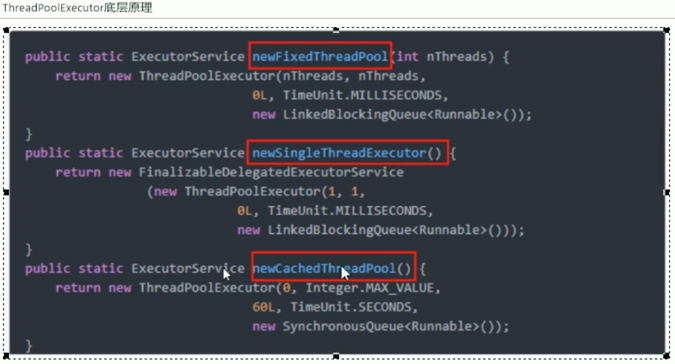
/**
* Creates a new {@code ThreadPoolExecutor} with the given initial
* parameters.
*
* @param corePoolSize 线程池的常驻核心线程数
* @param maximumPoolSize 线程池中能狗容纳同时执行的最大线程数,此值必须大于等于1
* @param keepAliveTime 多于线程的存或时间 当线程池中的线程数量超过corePoolSize时,
* 当空闲时间到达keepAlivetime时, 多余线程会被销毁知道只剩下corePoolSize个线程位为止
* @param unit keepAliveTime 的单位
* @param workQueue 任务队列, 被提交但尚未被执行的任务
* @param threadFactory 表示生产线程池中工作线程的线程工厂 (一般默认即可)
* @param handler 拒绝策略, 表示队列满了,并且工作线程大于等于线程池的最大数maximumPoolSize时,
* 如何来拒绝请求执行的Runable的策略
*/
public ThreadPoolExecutor(int corePoolSize,
int maximumPoolSize,
long keepAliveTime,
TimeUnit unit,
BlockingQueue<Runnable> workQueue,
ThreadFactory threadFactory,
RejectedExecutionHandler handler) {
if (corePoolSize < 0 ||
maximumPoolSize <= 0 ||
maximumPoolSize < corePoolSize ||
keepAliveTime < 0)
throw new IllegalArgumentException();
if (workQueue == null || threadFactory == null || handler == null)
throw new NullPointerException();
this.corePoolSize = corePoolSize;
this.maximumPoolSize = maximumPoolSize;
this.workQueue = workQueue;
this.keepAliveTime = unit.toNanos(keepAliveTime);
this.threadFactory = threadFactory;
this.handler = handler;
}

5、线程池的底层工作原理



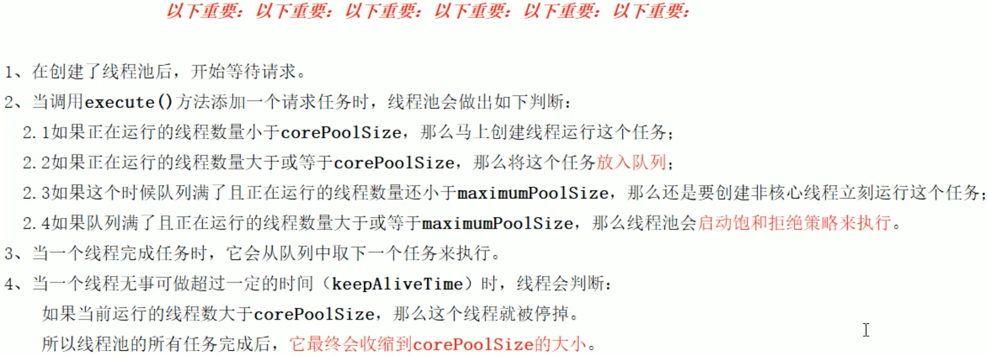
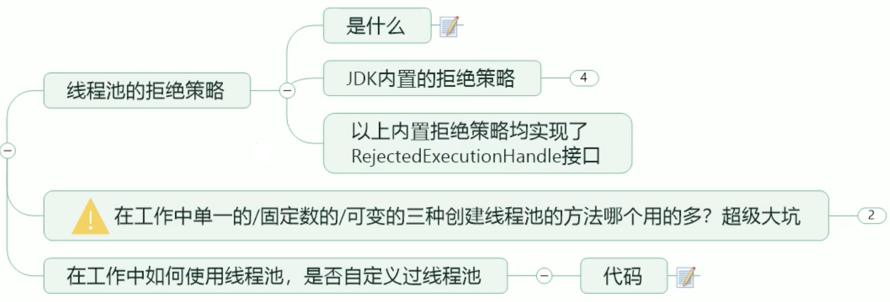
线程池用哪个

自定义线程池
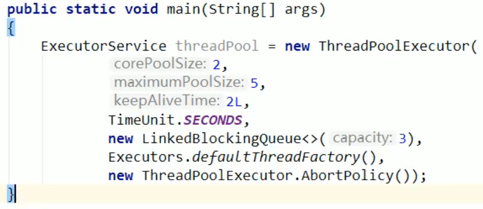
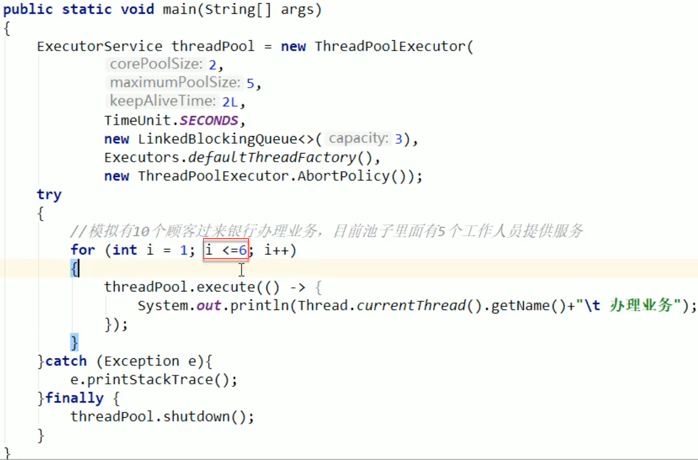
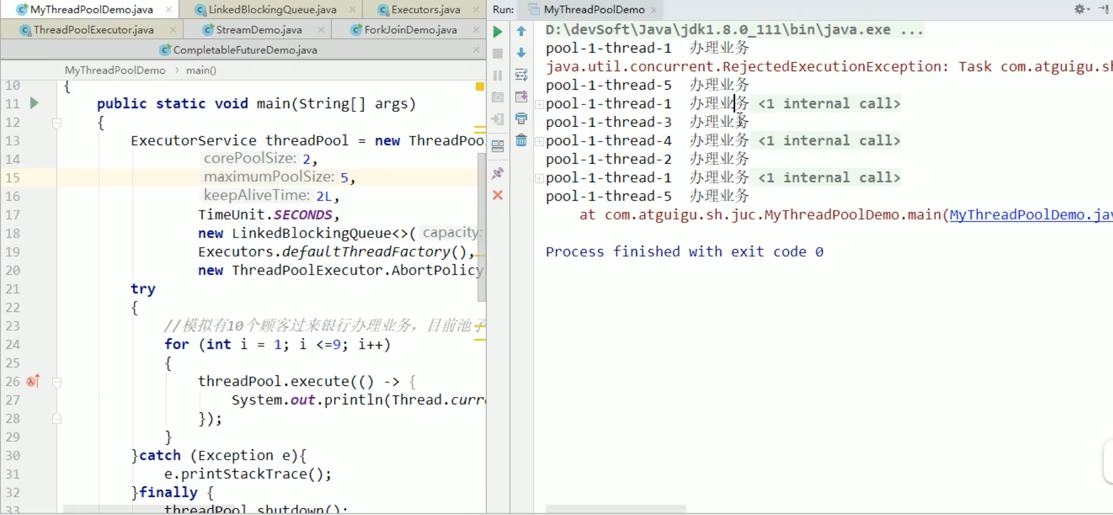
线程池的拒绝策略
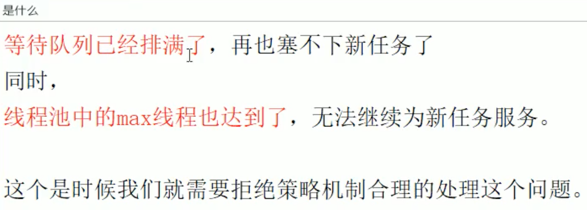
JDK内置决绝策略

ThreadPoolExecutor.AbortPolicy() 默认情况
直接抛出RejectedExecutionException 异常阻止系统正常运行
ThreadPoolExecutor. CallerRunsPolicy()
“调用者运行” 一种调节机制, 该策略既不会抛弃任务, 也不会抛出异常, 而是将某些任务回退到调用者, 从而降低新任务的流量.
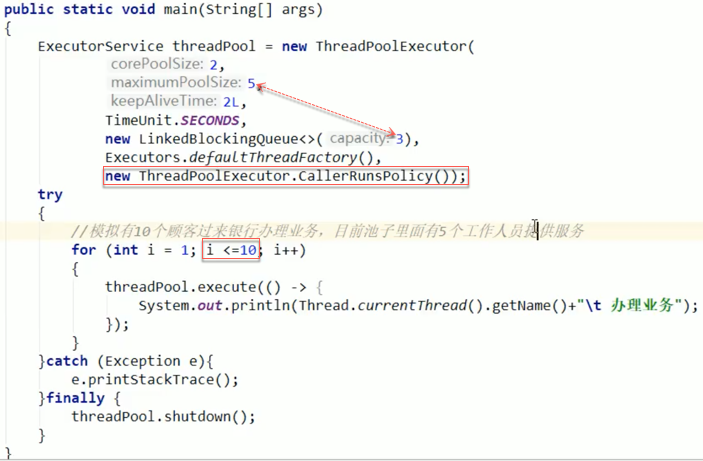

ThreadPoolExecutor.DiscardPolicy()
该策略默默的丢弃无法处理的任务, 不予任何处理也不抛出异常, 如果允许任务丢失,这是最好的一种策略
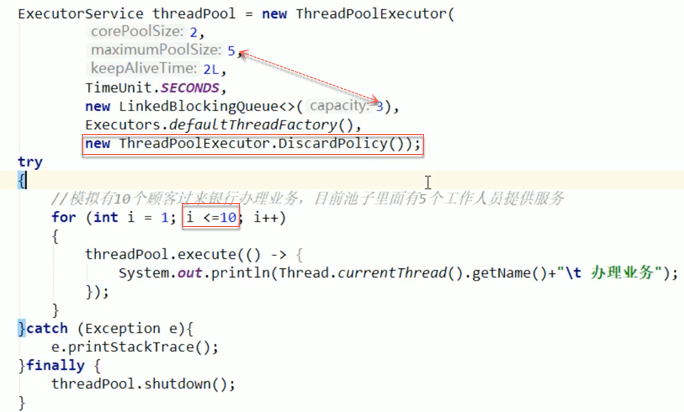
ThreadPoolExecutor.DiscardOldestPolicy()
抛弃队列中等待最久的任务, 然后把当前任务加到队列中,尝试再次提交当前任务
以上拒绝策略都实现了
RejectExcutionHandle接口
参数设置
CPU密集型
最大线程数 是运行环境的cpu内核数 + 1
System.out.println(Runtime.getRuntime().availableProcessors());
IO密集型
一种考虑到IO密集型,大部分线程都阻塞,因此需要多配置线程数 :
参考公式 : cpu核数 /(1 - 阻塞系数) 阻塞系数:0.8 ~ 0.9
比如8核cpu :8 / (1 - 0.9)=80个线程数